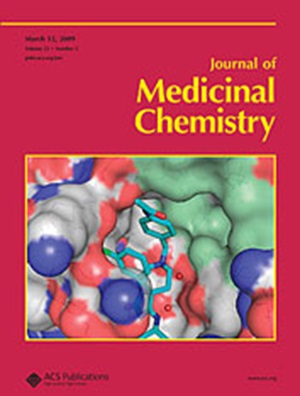肽双钉和精氨酸n -糖基化引发了能够杀死小鼠耐药细菌的治疗性抗菌肽的发展
IF 6.8
1区 医学
Q1 CHEMISTRY, MEDICINAL
引用次数: 0
摘要
抗菌肽SAAP-148具有良好的抗菌活性,但存在细胞毒性和蛋白水解稳定性差等缺点。在此,我们开发了一种独特的银催化固相糖基化精氨酸n-糖基化策略和全烃肽双钉接相结合的新策略,并合理构建了包含50多个钉接和/或精氨酸n-糖基化肽的5轮肽库。SLP-51由两个引入的全烃类主链和c端精氨酸糖基化组成,对耐药革兰氏阳性或阴性临床分离株具有较好的体外抗菌活性。SLP-51也比亲本肽SLP-0表现出更好的蛋白水解稳定性,重要的是,它显著减弱了溶血作用。实验和模型机制研究表明,SLP-51通过破坏细菌膜的完整性而具有类似但更强的杀伤能力。在皮肤伤口和耐药细菌性肺炎模型中,SLP-51在体内治疗MRSA和肺炎克雷伯菌感染均显示出有效的治疗效果,并显着改善炎症损伤。本文章由计算机程序翻译,如有差异,请以英文原文为准。

Peptide Double-Stapling and Arginine N-Glycosylation Triggered the Development of Therapeutic Antimicrobial Peptides Capable of Killing Drug-Resistant Bacteria in Mice
Antimicrobial peptides SAAP-148 exhibited excellent antimicrobial activities but suffered from inherent disadvantages, including cytotoxicity and poor proteolytic stability. Herein, we developed a novel strategy combining one unique silver-catalyzed solid-phase glycosylation-enabled arginine N-glycosylation strategy and all-hydrocarbon peptide double-stapling, and five-round peptide libraries were rationally constructed containing over 50 stapled and/or arginine N-glycosylated peptides. SLP-51 consisting of two introduced all-hydrocarbon staples and the C-terminal arginine glycosylation exhibited superior in vitro antimicrobial activities against drug-resistant Gram-positive or -negative clinical isolates. SLP-51 also exhibited improved proteolytic stability than the parent peptide SLP-0, and importantly, significantly weakened hemolysis. Experimental and modeling mechanism research indicated that SLP-51 exerted similar but stronger killing abilities by destroying the integrality of the bacterial membranes. In both skin wound and drug-resistant bacterial pneumonia models, SLP-51 showcased a potent therapeutic effect in treating both MRSA and Klebsiella pneumoniae infection in vivo and dramatical improvement of inflammatory injury.
求助全文
通过发布文献求助,成功后即可免费获取论文全文。
去求助
来源期刊

Journal of Medicinal Chemistry
医学-医药化学
CiteScore
4.00
自引率
11.00%
发文量
804
审稿时长
1.9 months
期刊介绍:
The Journal of Medicinal Chemistry is a prestigious biweekly peer-reviewed publication that focuses on the multifaceted field of medicinal chemistry. Since its inception in 1959 as the Journal of Medicinal and Pharmaceutical Chemistry, it has evolved to become a cornerstone in the dissemination of research findings related to the design, synthesis, and development of therapeutic agents.
The Journal of Medicinal Chemistry is recognized for its significant impact in the scientific community, as evidenced by its 2022 impact factor of 7.3. This metric reflects the journal's influence and the importance of its content in shaping the future of drug discovery and development. The journal serves as a vital resource for chemists, pharmacologists, and other researchers interested in the molecular mechanisms of drug action and the optimization of therapeutic compounds.
 求助内容:
求助内容: 应助结果提醒方式:
应助结果提醒方式:


